Information Technology and ERP Systems in UK Supermarkets
VerifiedAdded on 2022/12/16
|8
|2527
|77
Report
AI Summary
This report examines the role of information and technology in UK supermarkets, focusing on the categories and types of information systems employed, including Transaction Processing Systems (TPS), Management Information Systems (MIS), and Decision Support Systems (DSS). It discusses Enterprise Resource Planning (ERP) systems, highlighting benefits such as competitive advantage, improved process efficiency, accurate forecasting, cost savings, increased productivity, and enhanced customer service. The report also addresses the challenges associated with deploying and using ERP systems, including the need for adequate training, implementation costs, employee retention, and maintenance costs. The conclusion provides recommendations for overcoming these challenges, emphasizing the importance of employee training, communication of benefits, and retention strategies. Desklib offers similar solved assignments and past papers for students.
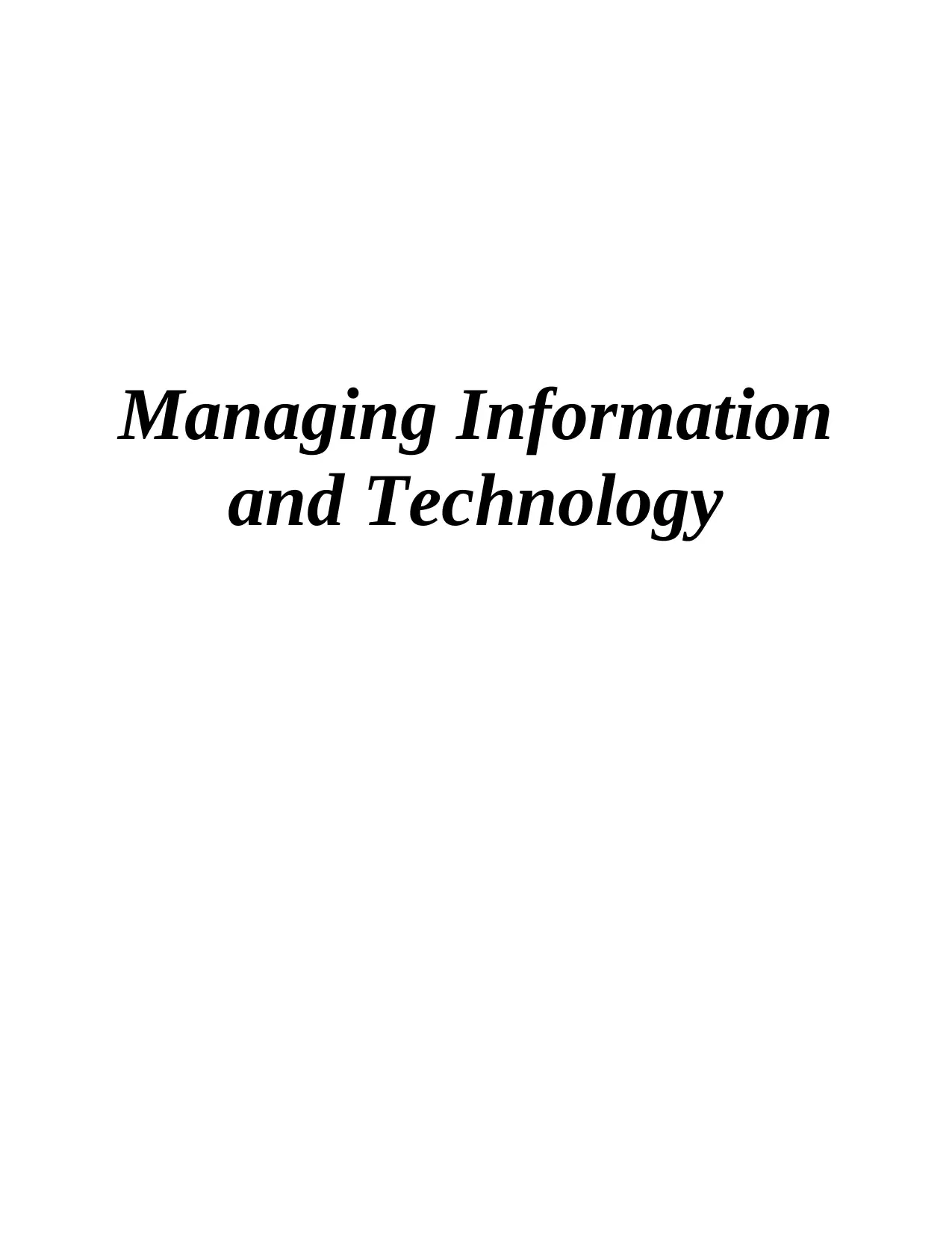
Managing Information
and Technology
and Technology
Paraphrase This Document
Need a fresh take? Get an instant paraphrase of this document with our AI Paraphraser
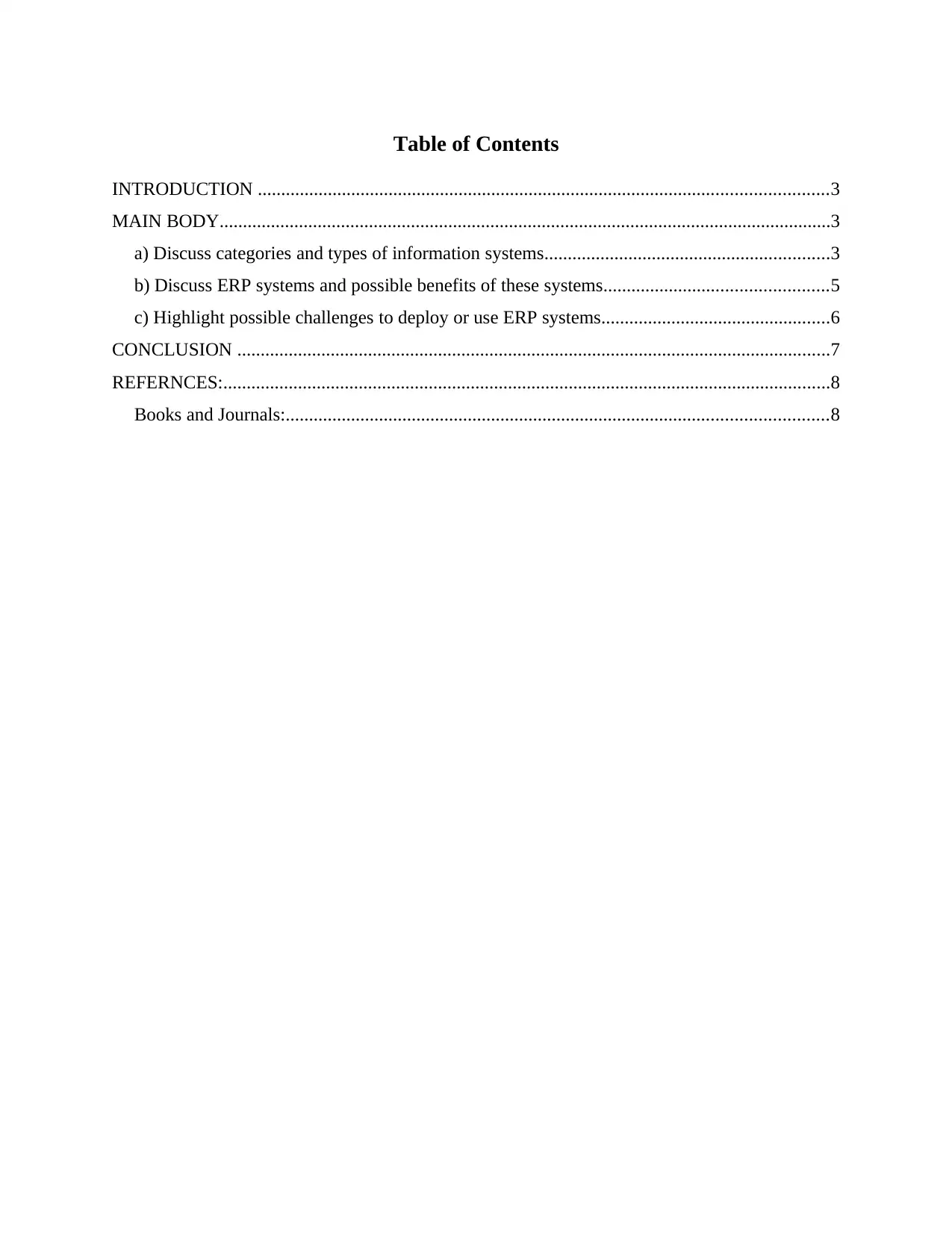
Table of Contents
INTRODUCTION ..........................................................................................................................3
MAIN BODY...................................................................................................................................3
a) Discuss categories and types of information systems.............................................................3
b) Discuss ERP systems and possible benefits of these systems................................................5
c) Highlight possible challenges to deploy or use ERP systems.................................................6
CONCLUSION ...............................................................................................................................7
REFERNCES:..................................................................................................................................8
Books and Journals:....................................................................................................................8
INTRODUCTION ..........................................................................................................................3
MAIN BODY...................................................................................................................................3
a) Discuss categories and types of information systems.............................................................3
b) Discuss ERP systems and possible benefits of these systems................................................5
c) Highlight possible challenges to deploy or use ERP systems.................................................6
CONCLUSION ...............................................................................................................................7
REFERNCES:..................................................................................................................................8
Books and Journals:....................................................................................................................8
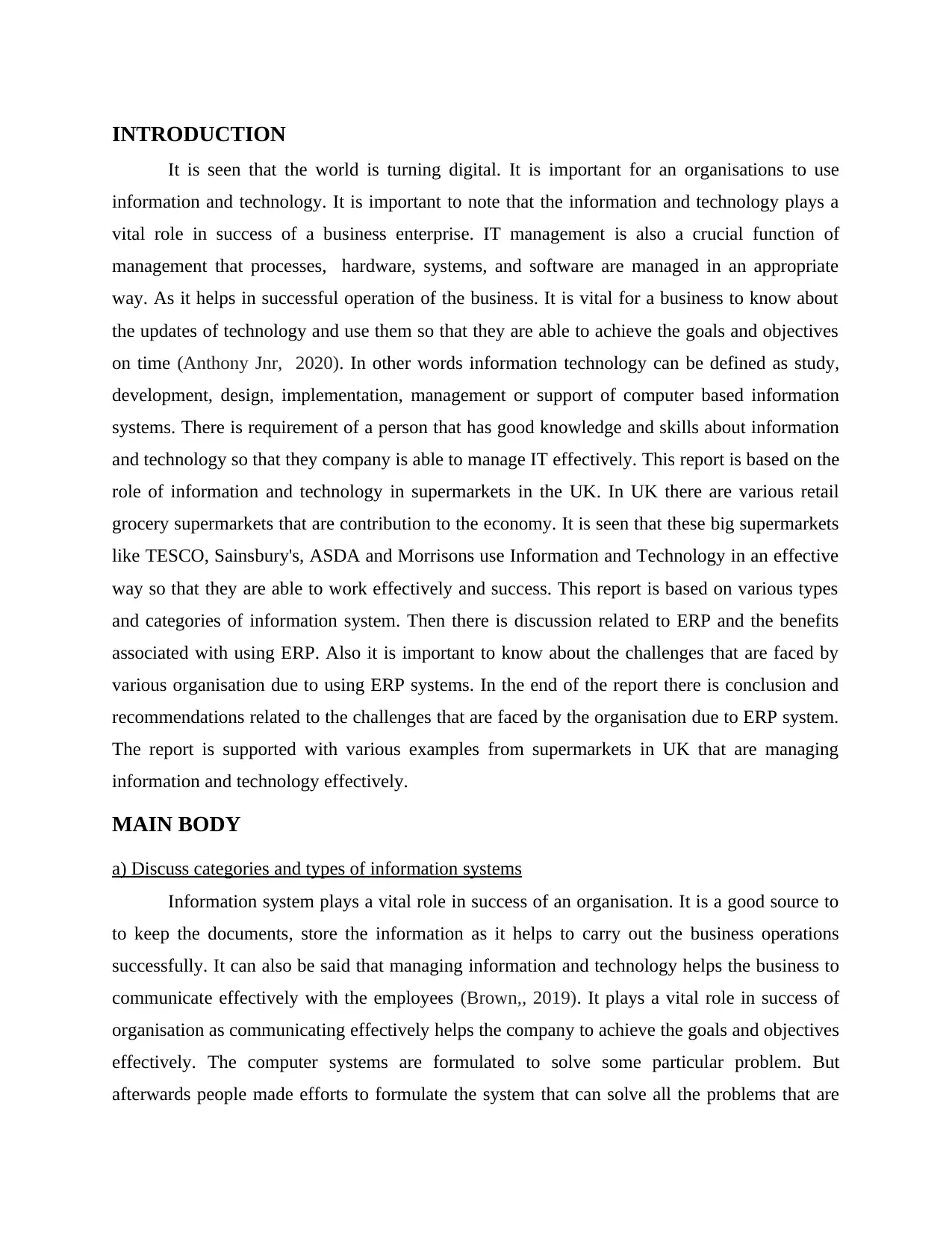
INTRODUCTION
It is seen that the world is turning digital. It is important for an organisations to use
information and technology. It is important to note that the information and technology plays a
vital role in success of a business enterprise. IT management is also a crucial function of
management that processes, hardware, systems, and software are managed in an appropriate
way. As it helps in successful operation of the business. It is vital for a business to know about
the updates of technology and use them so that they are able to achieve the goals and objectives
on time (Anthony Jnr, 2020). In other words information technology can be defined as study,
development, design, implementation, management or support of computer based information
systems. There is requirement of a person that has good knowledge and skills about information
and technology so that they company is able to manage IT effectively. This report is based on the
role of information and technology in supermarkets in the UK. In UK there are various retail
grocery supermarkets that are contribution to the economy. It is seen that these big supermarkets
like TESCO, Sainsbury's, ASDA and Morrisons use Information and Technology in an effective
way so that they are able to work effectively and success. This report is based on various types
and categories of information system. Then there is discussion related to ERP and the benefits
associated with using ERP. Also it is important to know about the challenges that are faced by
various organisation due to using ERP systems. In the end of the report there is conclusion and
recommendations related to the challenges that are faced by the organisation due to ERP system.
The report is supported with various examples from supermarkets in UK that are managing
information and technology effectively.
MAIN BODY
a) Discuss categories and types of information systems
Information system plays a vital role in success of an organisation. It is a good source to
to keep the documents, store the information as it helps to carry out the business operations
successfully. It can also be said that managing information and technology helps the business to
communicate effectively with the employees (Brown,, 2019). It plays a vital role in success of
organisation as communicating effectively helps the company to achieve the goals and objectives
effectively. The computer systems are formulated to solve some particular problem. But
afterwards people made efforts to formulate the system that can solve all the problems that are
It is seen that the world is turning digital. It is important for an organisations to use
information and technology. It is important to note that the information and technology plays a
vital role in success of a business enterprise. IT management is also a crucial function of
management that processes, hardware, systems, and software are managed in an appropriate
way. As it helps in successful operation of the business. It is vital for a business to know about
the updates of technology and use them so that they are able to achieve the goals and objectives
on time (Anthony Jnr, 2020). In other words information technology can be defined as study,
development, design, implementation, management or support of computer based information
systems. There is requirement of a person that has good knowledge and skills about information
and technology so that they company is able to manage IT effectively. This report is based on the
role of information and technology in supermarkets in the UK. In UK there are various retail
grocery supermarkets that are contribution to the economy. It is seen that these big supermarkets
like TESCO, Sainsbury's, ASDA and Morrisons use Information and Technology in an effective
way so that they are able to work effectively and success. This report is based on various types
and categories of information system. Then there is discussion related to ERP and the benefits
associated with using ERP. Also it is important to know about the challenges that are faced by
various organisation due to using ERP systems. In the end of the report there is conclusion and
recommendations related to the challenges that are faced by the organisation due to ERP system.
The report is supported with various examples from supermarkets in UK that are managing
information and technology effectively.
MAIN BODY
a) Discuss categories and types of information systems
Information system plays a vital role in success of an organisation. It is a good source to
to keep the documents, store the information as it helps to carry out the business operations
successfully. It can also be said that managing information and technology helps the business to
communicate effectively with the employees (Brown,, 2019). It plays a vital role in success of
organisation as communicating effectively helps the company to achieve the goals and objectives
effectively. The computer systems are formulated to solve some particular problem. But
afterwards people made efforts to formulate the system that can solve all the problems that are
⊘ This is a preview!⊘
Do you want full access?
Subscribe today to unlock all pages.

Trusted by 1+ million students worldwide
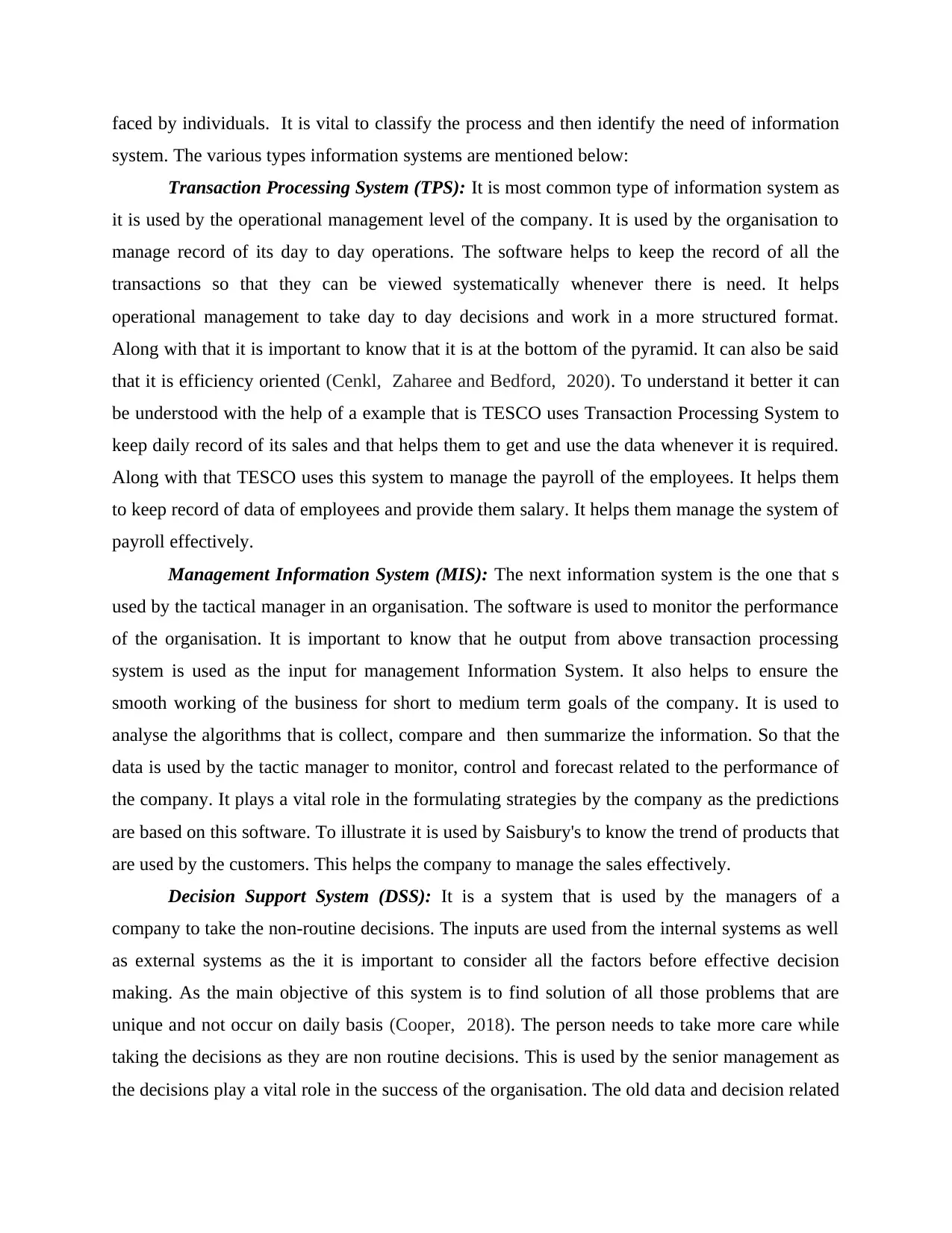
faced by individuals. It is vital to classify the process and then identify the need of information
system. The various types information systems are mentioned below:
Transaction Processing System (TPS): It is most common type of information system as
it is used by the operational management level of the company. It is used by the organisation to
manage record of its day to day operations. The software helps to keep the record of all the
transactions so that they can be viewed systematically whenever there is need. It helps
operational management to take day to day decisions and work in a more structured format.
Along with that it is important to know that it is at the bottom of the pyramid. It can also be said
that it is efficiency oriented (Cenkl, Zaharee and Bedford, 2020). To understand it better it can
be understood with the help of a example that is TESCO uses Transaction Processing System to
keep daily record of its sales and that helps them to get and use the data whenever it is required.
Along with that TESCO uses this system to manage the payroll of the employees. It helps them
to keep record of data of employees and provide them salary. It helps them manage the system of
payroll effectively.
Management Information System (MIS): The next information system is the one that s
used by the tactical manager in an organisation. The software is used to monitor the performance
of the organisation. It is important to know that he output from above transaction processing
system is used as the input for management Information System. It also helps to ensure the
smooth working of the business for short to medium term goals of the company. It is used to
analyse the algorithms that is collect, compare and then summarize the information. So that the
data is used by the tactic manager to monitor, control and forecast related to the performance of
the company. It plays a vital role in the formulating strategies by the company as the predictions
are based on this software. To illustrate it is used by Saisbury's to know the trend of products that
are used by the customers. This helps the company to manage the sales effectively.
Decision Support System (DSS): It is a system that is used by the managers of a
company to take the non-routine decisions. The inputs are used from the internal systems as well
as external systems as the it is important to consider all the factors before effective decision
making. As the main objective of this system is to find solution of all those problems that are
unique and not occur on daily basis (Cooper, 2018). The person needs to take more care while
taking the decisions as they are non routine decisions. This is used by the senior management as
the decisions play a vital role in the success of the organisation. The old data and decision related
system. The various types information systems are mentioned below:
Transaction Processing System (TPS): It is most common type of information system as
it is used by the operational management level of the company. It is used by the organisation to
manage record of its day to day operations. The software helps to keep the record of all the
transactions so that they can be viewed systematically whenever there is need. It helps
operational management to take day to day decisions and work in a more structured format.
Along with that it is important to know that it is at the bottom of the pyramid. It can also be said
that it is efficiency oriented (Cenkl, Zaharee and Bedford, 2020). To understand it better it can
be understood with the help of a example that is TESCO uses Transaction Processing System to
keep daily record of its sales and that helps them to get and use the data whenever it is required.
Along with that TESCO uses this system to manage the payroll of the employees. It helps them
to keep record of data of employees and provide them salary. It helps them manage the system of
payroll effectively.
Management Information System (MIS): The next information system is the one that s
used by the tactical manager in an organisation. The software is used to monitor the performance
of the organisation. It is important to know that he output from above transaction processing
system is used as the input for management Information System. It also helps to ensure the
smooth working of the business for short to medium term goals of the company. It is used to
analyse the algorithms that is collect, compare and then summarize the information. So that the
data is used by the tactic manager to monitor, control and forecast related to the performance of
the company. It plays a vital role in the formulating strategies by the company as the predictions
are based on this software. To illustrate it is used by Saisbury's to know the trend of products that
are used by the customers. This helps the company to manage the sales effectively.
Decision Support System (DSS): It is a system that is used by the managers of a
company to take the non-routine decisions. The inputs are used from the internal systems as well
as external systems as the it is important to consider all the factors before effective decision
making. As the main objective of this system is to find solution of all those problems that are
unique and not occur on daily basis (Cooper, 2018). The person needs to take more care while
taking the decisions as they are non routine decisions. This is used by the senior management as
the decisions play a vital role in the success of the organisation. The old data and decision related
Paraphrase This Document
Need a fresh take? Get an instant paraphrase of this document with our AI Paraphraser
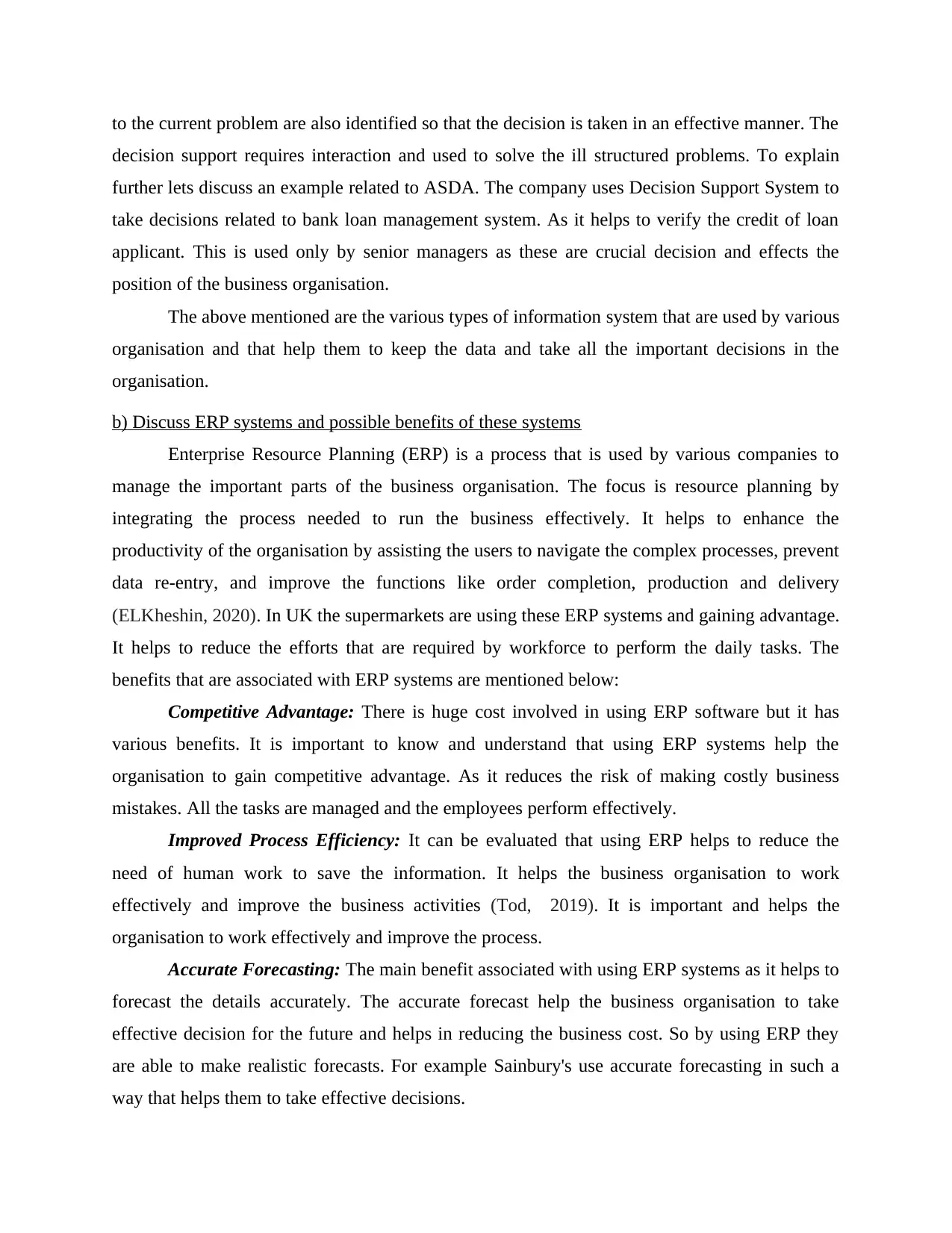
to the current problem are also identified so that the decision is taken in an effective manner. The
decision support requires interaction and used to solve the ill structured problems. To explain
further lets discuss an example related to ASDA. The company uses Decision Support System to
take decisions related to bank loan management system. As it helps to verify the credit of loan
applicant. This is used only by senior managers as these are crucial decision and effects the
position of the business organisation.
The above mentioned are the various types of information system that are used by various
organisation and that help them to keep the data and take all the important decisions in the
organisation.
b) Discuss ERP systems and possible benefits of these systems
Enterprise Resource Planning (ERP) is a process that is used by various companies to
manage the important parts of the business organisation. The focus is resource planning by
integrating the process needed to run the business effectively. It helps to enhance the
productivity of the organisation by assisting the users to navigate the complex processes, prevent
data re-entry, and improve the functions like order completion, production and delivery
(ELKheshin, 2020). In UK the supermarkets are using these ERP systems and gaining advantage.
It helps to reduce the efforts that are required by workforce to perform the daily tasks. The
benefits that are associated with ERP systems are mentioned below:
Competitive Advantage: There is huge cost involved in using ERP software but it has
various benefits. It is important to know and understand that using ERP systems help the
organisation to gain competitive advantage. As it reduces the risk of making costly business
mistakes. All the tasks are managed and the employees perform effectively.
Improved Process Efficiency: It can be evaluated that using ERP helps to reduce the
need of human work to save the information. It helps the business organisation to work
effectively and improve the business activities (Tod, 2019). It is important and helps the
organisation to work effectively and improve the process.
Accurate Forecasting: The main benefit associated with using ERP systems as it helps to
forecast the details accurately. The accurate forecast help the business organisation to take
effective decision for the future and helps in reducing the business cost. So by using ERP they
are able to make realistic forecasts. For example Sainbury's use accurate forecasting in such a
way that helps them to take effective decisions.
decision support requires interaction and used to solve the ill structured problems. To explain
further lets discuss an example related to ASDA. The company uses Decision Support System to
take decisions related to bank loan management system. As it helps to verify the credit of loan
applicant. This is used only by senior managers as these are crucial decision and effects the
position of the business organisation.
The above mentioned are the various types of information system that are used by various
organisation and that help them to keep the data and take all the important decisions in the
organisation.
b) Discuss ERP systems and possible benefits of these systems
Enterprise Resource Planning (ERP) is a process that is used by various companies to
manage the important parts of the business organisation. The focus is resource planning by
integrating the process needed to run the business effectively. It helps to enhance the
productivity of the organisation by assisting the users to navigate the complex processes, prevent
data re-entry, and improve the functions like order completion, production and delivery
(ELKheshin, 2020). In UK the supermarkets are using these ERP systems and gaining advantage.
It helps to reduce the efforts that are required by workforce to perform the daily tasks. The
benefits that are associated with ERP systems are mentioned below:
Competitive Advantage: There is huge cost involved in using ERP software but it has
various benefits. It is important to know and understand that using ERP systems help the
organisation to gain competitive advantage. As it reduces the risk of making costly business
mistakes. All the tasks are managed and the employees perform effectively.
Improved Process Efficiency: It can be evaluated that using ERP helps to reduce the
need of human work to save the information. It helps the business organisation to work
effectively and improve the business activities (Tod, 2019). It is important and helps the
organisation to work effectively and improve the process.
Accurate Forecasting: The main benefit associated with using ERP systems as it helps to
forecast the details accurately. The accurate forecast help the business organisation to take
effective decision for the future and helps in reducing the business cost. So by using ERP they
are able to make realistic forecasts. For example Sainbury's use accurate forecasting in such a
way that helps them to take effective decisions.
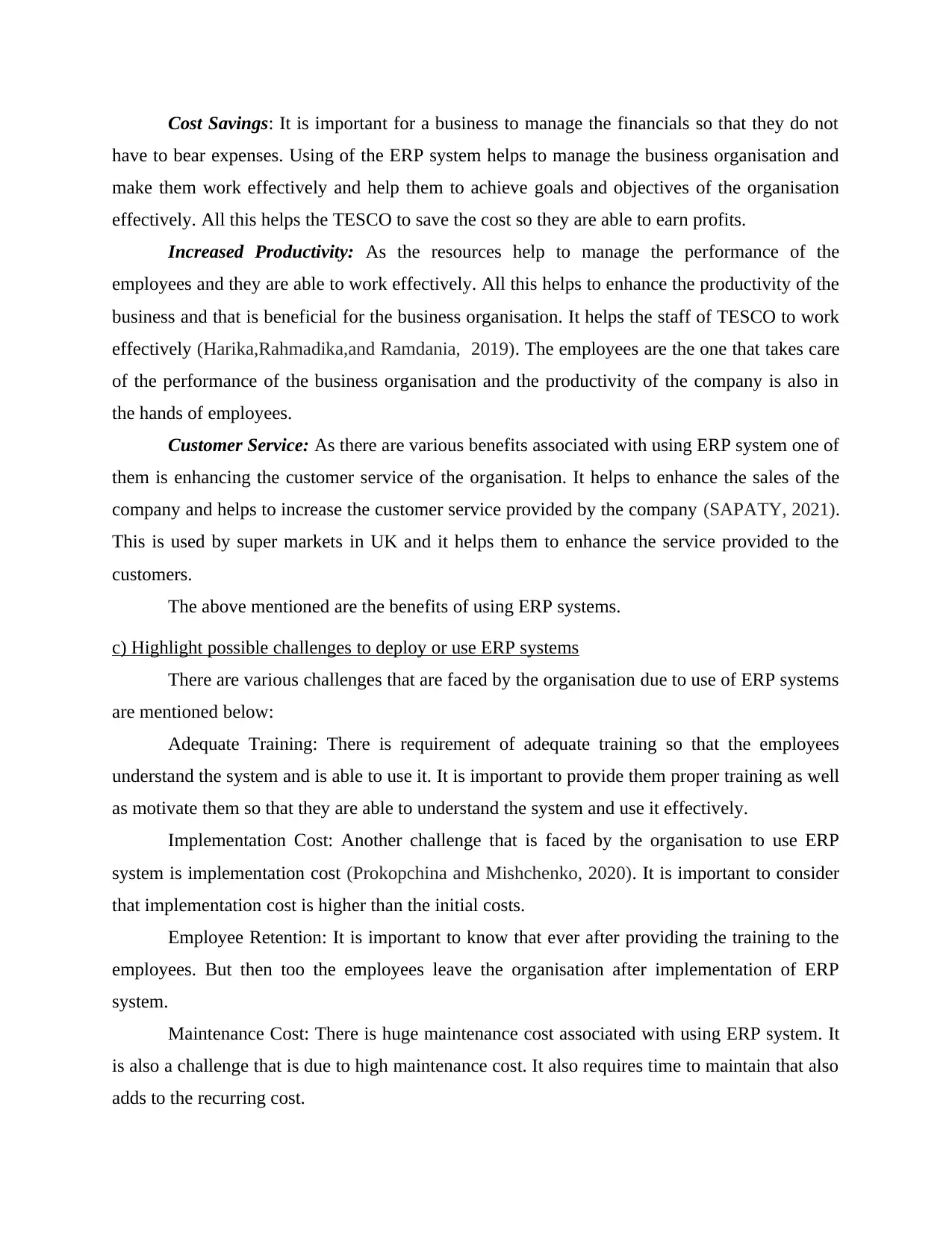
Cost Savings: It is important for a business to manage the financials so that they do not
have to bear expenses. Using of the ERP system helps to manage the business organisation and
make them work effectively and help them to achieve goals and objectives of the organisation
effectively. All this helps the TESCO to save the cost so they are able to earn profits.
Increased Productivity: As the resources help to manage the performance of the
employees and they are able to work effectively. All this helps to enhance the productivity of the
business and that is beneficial for the business organisation. It helps the staff of TESCO to work
effectively (Harika,Rahmadika,and Ramdania, 2019). The employees are the one that takes care
of the performance of the business organisation and the productivity of the company is also in
the hands of employees.
Customer Service: As there are various benefits associated with using ERP system one of
them is enhancing the customer service of the organisation. It helps to enhance the sales of the
company and helps to increase the customer service provided by the company (SAPATY, 2021).
This is used by super markets in UK and it helps them to enhance the service provided to the
customers.
The above mentioned are the benefits of using ERP systems.
c) Highlight possible challenges to deploy or use ERP systems
There are various challenges that are faced by the organisation due to use of ERP systems
are mentioned below:
Adequate Training: There is requirement of adequate training so that the employees
understand the system and is able to use it. It is important to provide them proper training as well
as motivate them so that they are able to understand the system and use it effectively.
Implementation Cost: Another challenge that is faced by the organisation to use ERP
system is implementation cost (Prokopchina and Mishchenko, 2020). It is important to consider
that implementation cost is higher than the initial costs.
Employee Retention: It is important to know that ever after providing the training to the
employees. But then too the employees leave the organisation after implementation of ERP
system.
Maintenance Cost: There is huge maintenance cost associated with using ERP system. It
is also a challenge that is due to high maintenance cost. It also requires time to maintain that also
adds to the recurring cost.
have to bear expenses. Using of the ERP system helps to manage the business organisation and
make them work effectively and help them to achieve goals and objectives of the organisation
effectively. All this helps the TESCO to save the cost so they are able to earn profits.
Increased Productivity: As the resources help to manage the performance of the
employees and they are able to work effectively. All this helps to enhance the productivity of the
business and that is beneficial for the business organisation. It helps the staff of TESCO to work
effectively (Harika,Rahmadika,and Ramdania, 2019). The employees are the one that takes care
of the performance of the business organisation and the productivity of the company is also in
the hands of employees.
Customer Service: As there are various benefits associated with using ERP system one of
them is enhancing the customer service of the organisation. It helps to enhance the sales of the
company and helps to increase the customer service provided by the company (SAPATY, 2021).
This is used by super markets in UK and it helps them to enhance the service provided to the
customers.
The above mentioned are the benefits of using ERP systems.
c) Highlight possible challenges to deploy or use ERP systems
There are various challenges that are faced by the organisation due to use of ERP systems
are mentioned below:
Adequate Training: There is requirement of adequate training so that the employees
understand the system and is able to use it. It is important to provide them proper training as well
as motivate them so that they are able to understand the system and use it effectively.
Implementation Cost: Another challenge that is faced by the organisation to use ERP
system is implementation cost (Prokopchina and Mishchenko, 2020). It is important to consider
that implementation cost is higher than the initial costs.
Employee Retention: It is important to know that ever after providing the training to the
employees. But then too the employees leave the organisation after implementation of ERP
system.
Maintenance Cost: There is huge maintenance cost associated with using ERP system. It
is also a challenge that is due to high maintenance cost. It also requires time to maintain that also
adds to the recurring cost.
⊘ This is a preview!⊘
Do you want full access?
Subscribe today to unlock all pages.

Trusted by 1+ million students worldwide
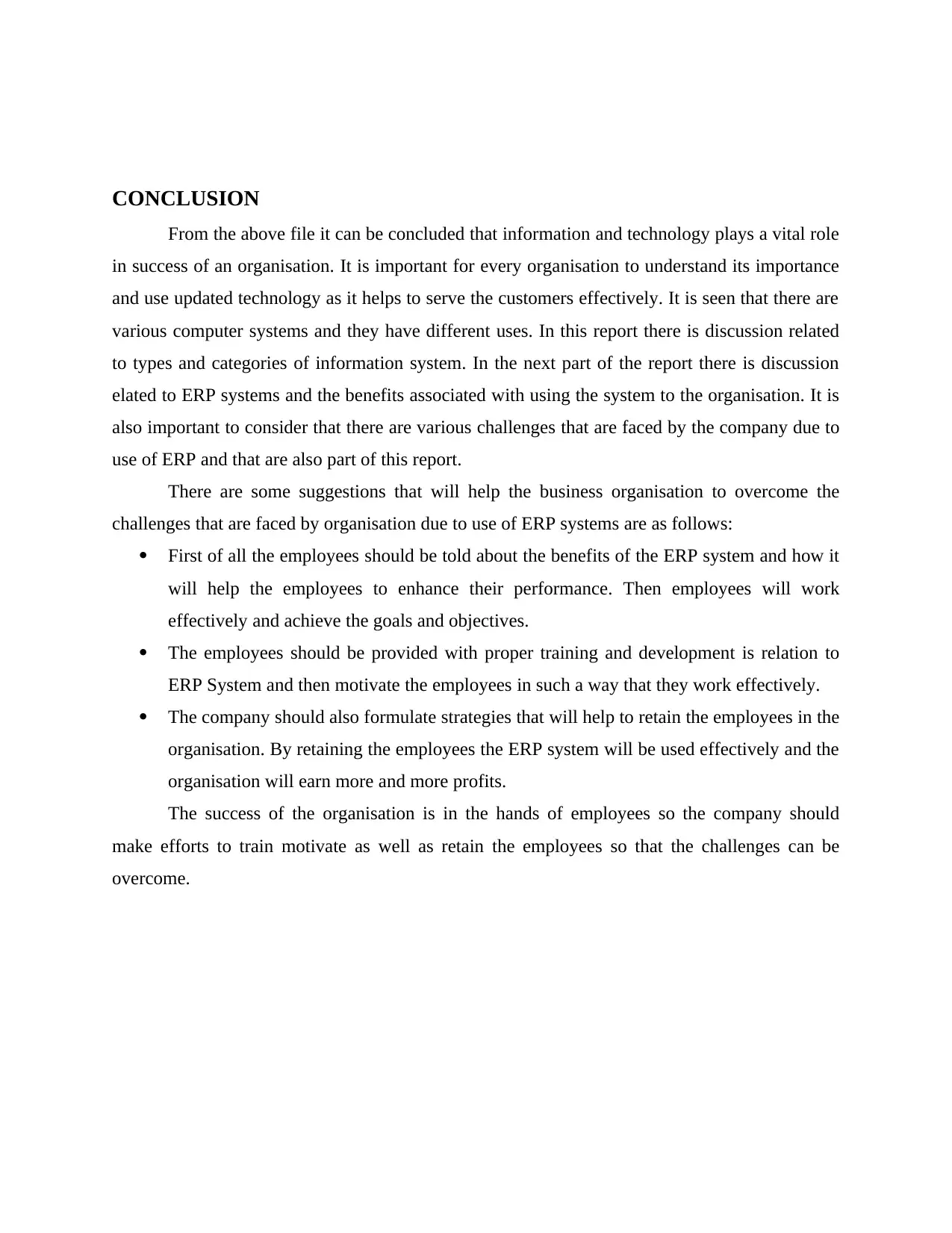
CONCLUSION
From the above file it can be concluded that information and technology plays a vital role
in success of an organisation. It is important for every organisation to understand its importance
and use updated technology as it helps to serve the customers effectively. It is seen that there are
various computer systems and they have different uses. In this report there is discussion related
to types and categories of information system. In the next part of the report there is discussion
elated to ERP systems and the benefits associated with using the system to the organisation. It is
also important to consider that there are various challenges that are faced by the company due to
use of ERP and that are also part of this report.
There are some suggestions that will help the business organisation to overcome the
challenges that are faced by organisation due to use of ERP systems are as follows:
First of all the employees should be told about the benefits of the ERP system and how it
will help the employees to enhance their performance. Then employees will work
effectively and achieve the goals and objectives.
The employees should be provided with proper training and development is relation to
ERP System and then motivate the employees in such a way that they work effectively.
The company should also formulate strategies that will help to retain the employees in the
organisation. By retaining the employees the ERP system will be used effectively and the
organisation will earn more and more profits.
The success of the organisation is in the hands of employees so the company should
make efforts to train motivate as well as retain the employees so that the challenges can be
overcome.
From the above file it can be concluded that information and technology plays a vital role
in success of an organisation. It is important for every organisation to understand its importance
and use updated technology as it helps to serve the customers effectively. It is seen that there are
various computer systems and they have different uses. In this report there is discussion related
to types and categories of information system. In the next part of the report there is discussion
elated to ERP systems and the benefits associated with using the system to the organisation. It is
also important to consider that there are various challenges that are faced by the company due to
use of ERP and that are also part of this report.
There are some suggestions that will help the business organisation to overcome the
challenges that are faced by organisation due to use of ERP systems are as follows:
First of all the employees should be told about the benefits of the ERP system and how it
will help the employees to enhance their performance. Then employees will work
effectively and achieve the goals and objectives.
The employees should be provided with proper training and development is relation to
ERP System and then motivate the employees in such a way that they work effectively.
The company should also formulate strategies that will help to retain the employees in the
organisation. By retaining the employees the ERP system will be used effectively and the
organisation will earn more and more profits.
The success of the organisation is in the hands of employees so the company should
make efforts to train motivate as well as retain the employees so that the challenges can be
overcome.
Paraphrase This Document
Need a fresh take? Get an instant paraphrase of this document with our AI Paraphraser
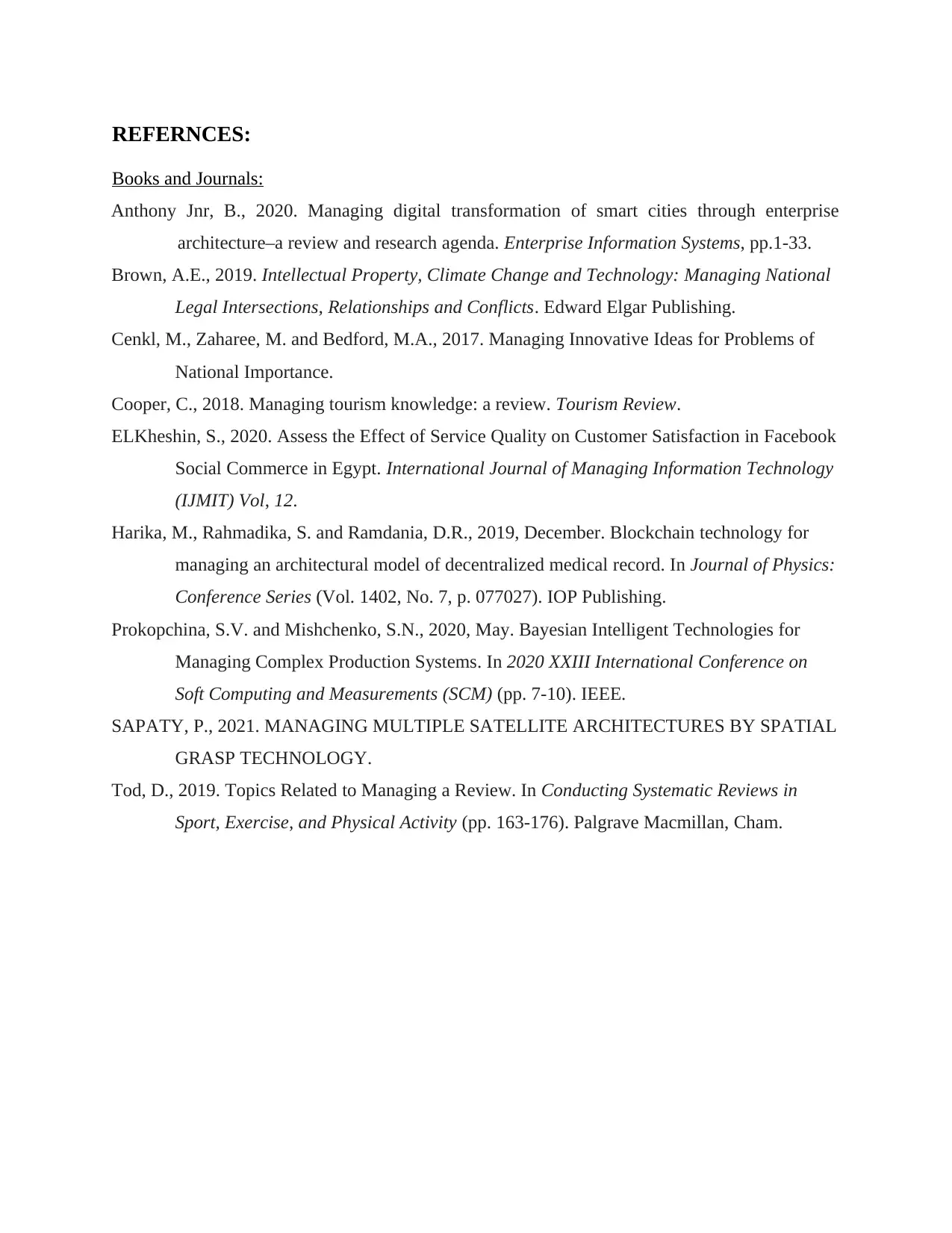
REFERNCES:
Books and Journals:
Anthony Jnr, B., 2020. Managing digital transformation of smart cities through enterprise
architecture–a review and research agenda. Enterprise Information Systems, pp.1-33.
Brown, A.E., 2019. Intellectual Property, Climate Change and Technology: Managing National
Legal Intersections, Relationships and Conflicts. Edward Elgar Publishing.
Cenkl, M., Zaharee, M. and Bedford, M.A., 2017. Managing Innovative Ideas for Problems of
National Importance.
Cooper, C., 2018. Managing tourism knowledge: a review. Tourism Review.
ELKheshin, S., 2020. Assess the Effect of Service Quality on Customer Satisfaction in Facebook
Social Commerce in Egypt. International Journal of Managing Information Technology
(IJMIT) Vol, 12.
Harika, M., Rahmadika, S. and Ramdania, D.R., 2019, December. Blockchain technology for
managing an architectural model of decentralized medical record. In Journal of Physics:
Conference Series (Vol. 1402, No. 7, p. 077027). IOP Publishing.
Prokopchina, S.V. and Mishchenko, S.N., 2020, May. Bayesian Intelligent Technologies for
Managing Complex Production Systems. In 2020 XXIII International Conference on
Soft Computing and Measurements (SCM) (pp. 7-10). IEEE.
SAPATY, P., 2021. MANAGING MULTIPLE SATELLITE ARCHITECTURES BY SPATIAL
GRASP TECHNOLOGY.
Tod, D., 2019. Topics Related to Managing a Review. In Conducting Systematic Reviews in
Sport, Exercise, and Physical Activity (pp. 163-176). Palgrave Macmillan, Cham.
Books and Journals:
Anthony Jnr, B., 2020. Managing digital transformation of smart cities through enterprise
architecture–a review and research agenda. Enterprise Information Systems, pp.1-33.
Brown, A.E., 2019. Intellectual Property, Climate Change and Technology: Managing National
Legal Intersections, Relationships and Conflicts. Edward Elgar Publishing.
Cenkl, M., Zaharee, M. and Bedford, M.A., 2017. Managing Innovative Ideas for Problems of
National Importance.
Cooper, C., 2018. Managing tourism knowledge: a review. Tourism Review.
ELKheshin, S., 2020. Assess the Effect of Service Quality on Customer Satisfaction in Facebook
Social Commerce in Egypt. International Journal of Managing Information Technology
(IJMIT) Vol, 12.
Harika, M., Rahmadika, S. and Ramdania, D.R., 2019, December. Blockchain technology for
managing an architectural model of decentralized medical record. In Journal of Physics:
Conference Series (Vol. 1402, No. 7, p. 077027). IOP Publishing.
Prokopchina, S.V. and Mishchenko, S.N., 2020, May. Bayesian Intelligent Technologies for
Managing Complex Production Systems. In 2020 XXIII International Conference on
Soft Computing and Measurements (SCM) (pp. 7-10). IEEE.
SAPATY, P., 2021. MANAGING MULTIPLE SATELLITE ARCHITECTURES BY SPATIAL
GRASP TECHNOLOGY.
Tod, D., 2019. Topics Related to Managing a Review. In Conducting Systematic Reviews in
Sport, Exercise, and Physical Activity (pp. 163-176). Palgrave Macmillan, Cham.
1 out of 8
Related Documents
Your All-in-One AI-Powered Toolkit for Academic Success.
+13062052269
info@desklib.com
Available 24*7 on WhatsApp / Email
![[object Object]](/_next/static/media/star-bottom.7253800d.svg)
Unlock your academic potential
Copyright © 2020–2025 A2Z Services. All Rights Reserved. Developed and managed by ZUCOL.




